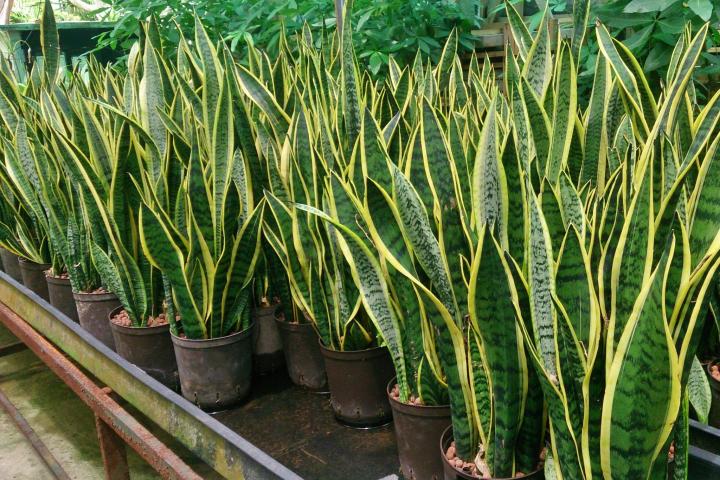To care for a snake plant outdoors, provide well-draining soil and avoid overwatering. Snake plants are a popular choice for outdoor gardens due to their striking appearance and low maintenance needs.
These hardy plants thrive in well-draining soil, so make sure to plant them in a mixture of sand, peat moss, and potting mix. Avoid overwatering, as snake plants are drought-tolerant and can easily rot if their roots sit in water for too long.

Credit: www.almanac.com
Place them in a spot that receives bright, indirect sunlight, as direct sunlight can scorch their leaves. With minimal care, your snake plant will flourish in your outdoor space, adding a touch of beauty and elegance to your garden.
How to Care for Snake Plant Outdoors : Step by Step Guide
Optimal Outdoor Conditions
Snake plants are a popular choice for outdoor gardens due to their hardy nature and low maintenance requirements. When caring for snake plants outdoors, it is important to provide them with optimal conditions. They require moderate to bright indirect sunlight to thrive, so choose a location that offers these conditions. The ideal temperature range for outdoor snake plants is between 60°F and 85°F. Well-drained soil is crucial to prevent root rot, so make sure to use a mixture of loamy soil and sand.
Outdoor snake plants should be watered sparingly, allowing the soil to dry out between waterings. It is also important to choose an appropriately sized pot with good drainage. Lastly, find a suitable spot that is protected from extreme weather conditions and strong winds. Follow these guidelines, and your snake plant will thrive in outdoor settings.
Pests And Diseases: Prevention And Treatment
Common pests that infest outdoor snake plantsOutdoor snake plants are susceptible to common pests like aphids, mealybugs, and spider mites. These pests can weaken the plant, hinder its growth, and lead to further infestations. It is essential to spot and eliminate these pests at the earliest signs of infestation. Effective organic remedies for pest controlTo control pests organically, you can create a mixture of neem oil and water and spray it on the affected areas of the plant. The solution acts as a deterrent to pests while being safe for the plant. Additionally, introducing beneficial insects like ladybugs can help control pest populations naturally. Signs and symptoms of diseases in outdoor snake plantsOutdoor snake plants are prone to diseases such as root rot, leaf spot, and fungal infections. Common symptoms include yellowing or browning leaves, drooping, and wilting. Regular inspection and early detection are key to preventing the spread of diseases. Preventive measures to maintain plant healthTo maintain the health of your outdoor snake plants, ensure they receive adequate sunlight and are planted in well-draining soil. Avoid overwatering, as it can lead to root rot and other fungal infections. Implementing proper spacing between plants also helps prevent the spread of diseases. Natural treatments for common snake plant diseasesIf diseases are detected, natural treatments like spraying a mixture of baking soda and water onto affected areas can help control fungal infections. Trimming infected leaves and applying a natural fungicide can also aid in disease management. Regular inspection and maintenance routinesIt is crucial to regularly inspect your outdoor snake plants for pests and diseases. Check the leaves, stems, and soil for any abnormalities. Implement a routine maintenance schedule, including proper watering and fertilization, to keep your snake plants healthy and thriving. |
Pruning And Propagation Techniques
Understanding the growth pattern of outdoor snake plants is crucial for the proper care and maintenance of these plants. **Pruning** plays a significant role in **promoting better growth** and maintaining healthy foliage. Regular pruning helps remove dead leaves, encourages new growth, and maintains the plant’s overall shape. It is advisable to remove any dead or damaged leaves using sharp shears to prevent any unnecessary stress on the plant.
In addition to pruning, **propagation** is another technique to increase your snake plant collection. **Dividing** the plant is an effective method of propagation for outdoor snake plants. This involves carefully separating the plant into smaller divisions, making sure each division has healthy roots and leaves. Once divided, these new snake plant divisions can be potted in well-draining soil and placed in an area with partial sunlight and moderate humidity.
Routine **maintenance and care** for propagated snake plants include regular watering, but ensuring the soil is well-drained to prevent waterlogging. Snake plants are drought-tolerant, so it is essential not to overwater them. Keep an eye out for any signs of pests or diseases and address them promptly to prevent any damage to your outdoor snake plants.
Bonus Tips For Thriving Outdoor Snake Plants
A snake plant is a popular choice for outdoor gardening due to its low maintenance and resilience. To ensure your outdoor snake plants thrive, consider the following:
| Fertilizing Recommendations | Use a balanced liquid fertilizer diluted with water and apply it every two months during the growing season. |
| Seasonal Considerations | Adjust your care routine according to the seasons. During winter, reduce watering and avoid overexposing the plant to frost. |
| Reaching Full Potential | Encourage growth by providing adequate sunlight, well-draining soil, and occasional grooming to remove damaged leaves. |
| Aesthetically Pleasing Display | Create a visually appealing outdoor snake plant display by using different pot sizes, heights, and complementary plant companions. |
| Frequently Asked Questions | Get answers to common queries about caring for snake plants outdoors, such as dealing with pests or reviving a neglected plant. |
| Troubleshooting Tips | Consult expert advice to troubleshoot common snake plant issues like root rot, yellowing leaves, or pests. |
By following these tips, you can ensure your outdoor snake plants thrive and become a beautiful addition to your outdoor space.
Frequently Asked Questions For How To Care For Snake Plant Outdoors
Can A Snake Plant Survive Outside?
Yes, snake plants can survive outside as they are hardy and can tolerate different weather conditions.
Can I Keep A Potted Snake Plant Outside?
Yes, you can keep a potted snake plant outside as long as it receives indirect sunlight and moderate temperatures.
Do Snake Plants Need Direct Sunlight?
Snake plants do not need direct sunlight; they can thrive in lower light conditions.
Can A Snake Plant Stay Outside In Winter?
Snake plants can withstand cooler temperatures, but it’s best to bring them indoors during winter.
Conclusion
Caring for snake plants outdoors requires a little extra attention but can be a rewarding experience. By providing adequate sunlight, well-draining soil, and regular watering, you can ensure the health and vitality of your snake plant. Protecting it from extreme temperatures and providing a sheltered spot during harsh weather conditions is also important.
Pruning and repotting when necessary will help maintain its growth and appearance. Remember to keep an eye out for pests and diseases, promptly treating any issues that arise. With these simple yet effective tips, you can enjoy the beauty of your snake plant in your outdoor space, adding a touch of natural greenery and visual appeal.
So go ahead, give your snake plant the care it deserves, and watch it thrive in the great outdoors. Happy gardening!

